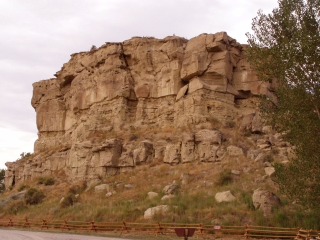Pompey's Pillar National Monument
near Billings, Mont.
Visited: August 21, 2004
NPS Site Visited: Not an NPS Site
Local Website
 WHAT IS IT? WHAT IS IT?
A sandstone butte alongside the Yellowstone River whose definitive feature is the graffiti signature of William Clark, one-half of the Lewis and Clark team. His autograph is only remaining physical evidence along the trail.
BEAUTY (5/10)
The mesa is impressive as is the view of the Yellowstone River below. Still, the boardwalk and the newly constructed grain elevators in the horizon obstruct the grand vista.
HISTORIC SIGNIFICANCE (6/10)
Clark, but not Lewis, was here. He left his signature, along with dozens of others before the rock became a protected landmark. The now famous rock was named after Sacagawea's son Jean Baptiste Charbonneau a.k.a. Pomp. Everyone else in the expedition was memorialized through the naming of rivers, streams, crossings, etc. so wny not Pomp.
Had Lewis or Clark been more prolific scrawlers and left their tags on other places, Pompey’s Pillar would really be no big deal. But they didn’t so it is.
CROWDS (6/10)
The few people that were touring the Monument did not influence our visit.
EASE OF USE/ACCESS (1/5)
Pompey’s Pillar is located a short distance from Exit 23 of Interstate 94 and is about 25 miles east of Billings, Mont. Once you leave the Interstate the mile or so road to the Site is unpaved as is the parking lot. Despite its proximity to 94, Pompey’s Pillar is a remote destination.
Clark’s signature can be reached only by walking up a boardwalk that includes many stairs. The boardwalk continues to the top of the butte. Sadly, you cannot veer from the wooden pathway, run around the top of the mesa and survey the scene as Clark did in 1806.
 CONCESSIONS/BOOKSTORE (2/5) CONCESSIONS/BOOKSTORE (2/5)
We have been to so many Lewis and Clark sites that the numerous book titles just blur together. Most of the books are available everywhere but not every site has the full boat of stuffed animals, T-shirts, patches, jigsaw puzzles and key chains. Pompey’s Pillar NM had a below average inventory which should change when the $4.9 million Yellowstone Interpretive Center opens in the spring of 2005.
COSTS (3/5)
The Site costs $3.00 per vehicle. Admission is free with the $15 National Parks Pass Golden Eagle Hologram Sticker Upgrade. The upgrade covers admission to all National Forests and Bureau of Land Management Sites.
RANGER/GUIDE TO TOURIST RATIO (3/5)
There was a Ranger at the makeshift Visitor Center as well as one standing underneath the signature ready to answer questions. “So, that’s Clark’s signature?” “Why yes, it is?” “From which angle can we get the best picture?” “Not sure, just try them all.” “So, uh, can we walk to the top?” “Yes, it is a beautiful view, just stay on the boardwalk.”
TOURS/CLASSES (2/10)
Currently there are no L&C explanations to speak of in the Visitor Center. We hope that this problem will soon be remedied. We wish that improvements could have been completed in time to celebrate the Lewis and Clark 2004 bicentennial.
We enjoyed the mimeographed sheet of paper on the Site’s door that explained where L&C where and what they were doing on this date 200 years ago. Why doesn’t every L&C Site do this?
FUN (4/10)
The Site’s restrictive nature severely limited our fun. We are unsure why we could not stray from the boardwalk. The several video cameras poised to capture the meandering tourist made us a bit paranoid and scared to enjoy ourselves, as did the harshly declarative signs telling us not to roam.
The signature itself is encased behind a steamy plastic barrier and is both hard to see and impossible to capture with a good picture. The attentive glare of the Ranger and the video camera made viewing Clark’s mark a rushed and nervous experience. We felt like we were in a department store and the clerk assumed we were going to steal something.
 WOULD WE RECOMMEND? (5/10) WOULD WE RECOMMEND? (5/10)
If you are on the Lewis and Clark Trail stop at Pompey’s Pillar. Clark’s signature attaches realness to what can at times be a journey of abstract historical imagination. He was here! There is his John Hancock, not just a statue, an Interpretive Center, a dammed-up river or a plaque.
TOTAL 37/80
|